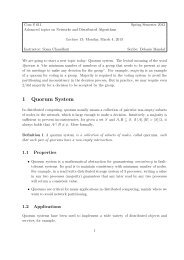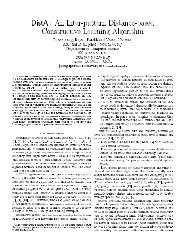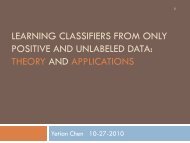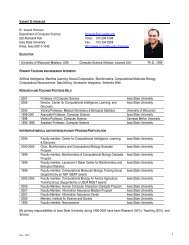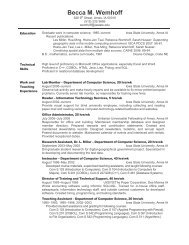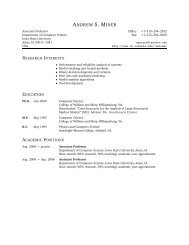Quaternions and Rotations∗ - Iowa State University
Quaternions and Rotations∗ - Iowa State University
Quaternions and Rotations∗ - Iowa State University
Create successful ePaper yourself
Turn your PDF publications into a flip-book with our unique Google optimized e-Paper software.
The cosine is same as obtained in Section 3 of the h<strong>and</strong>outs titled “Rotation in the Space” for we have<br />
cosθ = 2 cos 2 θ 2 − 1<br />
= 2 cos 2 α 2 cos2 β 2 − 1<br />
= 2 cosα + 1 · cosβ + 1 − 1<br />
2 2<br />
cosα cosβ + cosα + cosβ − 1<br />
= .<br />
2<br />
Note that the rotation axis <strong>and</strong> angle in that section transforms coordinates in the tracking frame to those<br />
in the station frame. This explains why the axis v in (7) is opposite to the one obtained in that section<br />
while the angle is the same.<br />
5 Application: 3-D Shape Registration<br />
An important problem in model-based recognition is to find the transformation of a set of data<br />
points that yields the best match of these points against a shape model. The process is often<br />
referred to as data registration. The data points are typically measured on a real object by range<br />
sensors, touch sensors, etc., <strong>and</strong> given in Cartesian coordinates. The quality of a match is often<br />
described as the total squared distance from the data points to the model. When multiple shape<br />
models are possible, the one that results in the least total distance is then recognized as the shape<br />
of the object.<br />
<strong>Quaternions</strong> are very effective in solving the above least-squares-based registration problem. Let<br />
us begin with a formulation of the problem in 3D. Let {p 1 ,p 2 ,... ,p n } be a set of data points. We<br />
assume that p 1 ,... ,p n are to be matched against the points q 1 ,... ,q n on a shape model. Namely,<br />
the correspondences between the data points <strong>and</strong> those on the model have been predetermined.<br />
Then the problem is to find a rotation, represented by an orthogonal matrix R with det(R) = 1,<br />
<strong>and</strong> a translation b as the solution to the following minimization:<br />
min<br />
R,b<br />
n∑<br />
‖Rp i + b − q i ‖ 2 . (8)<br />
i=1<br />
q 1<br />
q 5<br />
q 3<br />
p 1<br />
p 5<br />
p 3<br />
p 2<br />
rotation<br />
translation<br />
q 4<br />
q 7<br />
p 7<br />
q 6<br />
q 2<br />
p 4<br />
p 6<br />
Data<br />
Model<br />
8



